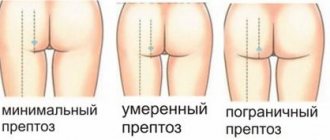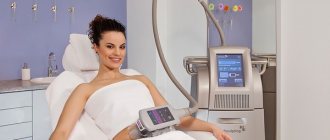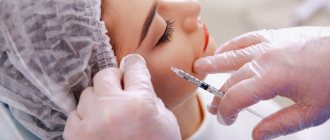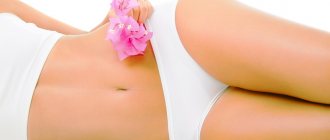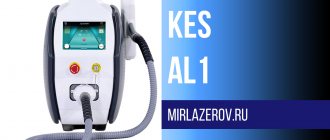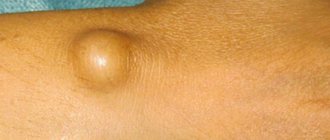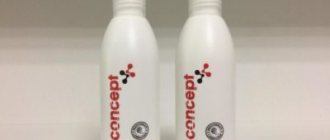Reviews from patients after cryolipolysis
Patient comments about the procedure are mostly positive:
- Ivan: I’ve been doing sports for a long time and I’m already seeing results. But the abs continue to hide under a layer of fat. I went through a “cutting” and did a lot of cardio, tried to combine a protein diet and amino acids. All in vain... But recently a cosmetology salon opened next to the gym. They brought in expensive equipment. Not a woman, of course, but I decided to try: 10 thousand per session. To be honest, it was very painful. Bruises are ugly and unpleasant to touch. But already in the third week I lost 3 cm in volume.
- Veronika Sopyatova: Cryolipolysis helped me make my stomach flat, which did not respond to diets and fitness. And then 1 procedure - and the dream came true.
- Yana: I’ve been struggling with excess weight almost all my life. I don’t have much of it (about 7 kg), but it has accumulated in the most problematic areas. Diets did not help, and hardware procedures removed everything in 8 sessions.
Reviews about pain after cryolipolysis have different opinions. Most women found the procedure unpleasant only for the first 3-5 minutes, while others did not notice any discomfort at all. Occasionally they write that therapy turned out to be more painful than expected.
Is there any pain during the procedure?
Patients do not experience pain, except for discomfort when pulling the problem area into the applicator. After just a few minutes, the fold goes numb and the burning goes away. With a low BMI, the procedure will be less comfortable, although there is still no need for pain relief.
Some people have a stomach ache after cryolipolysis: discomfort after the procedure is associated with the processes of breakdown of fat cells. Some people experience this without symptoms, others feel a burning sensation in the problem area. This is normal, but if the condition does not improve within 2-3 days, consult your doctor.
The main advantages of cryolipolysis
- Safety of the procedure;
- No possibility of tissue infection;
- A small number of contraindications to the procedure;
- During the cryolipolysis process, patients experience discomfort for the first 15 minutes, after which the procedure is completely comfortable;
- Fast and lasting results;
- No rehabilitation period: after cryolipolysis you can go to work, do everyday activities and not experience any discomfort;
- Impact on local areas of the body helps to get rid of fat deposits in specific places without affecting the entire body;
- Cryolipolysis can be performed at any time of the year;
- Unlike surgical methods, such as after liposuction, there is no need to wear special underwear;
- During the first session you can get rid of 20-50% of local fat deposits;
- The possibility of combining cryolipolysis with other procedures and cosmetic techniques.
Indications for use
Cryolipolysis is used to partially or completely eliminate fat deposits. The technique is recommended if the problem is:
- Dissatisfaction with your figure;
- Inactive lifestyle;
- Hormonal or “stagnant” fat;
- Local entities;
- Malfunctions of the body due to diseases and/or long-term use of drugs;
- Deposits do not go away when body volume is corrected in other ways;
- Initial stages of obesity;
- Eating disorders.
The patient’s BMI should be in the range from 25 to 30. With a higher indicator, the volume of fat mass is reduced using traditional methods (sports, proper nutrition, psychologist) and only then the procedure is prescribed. The main indication is a fat layer 2.5-6 cm thick.
Cold therapy reduces volume and has a beneficial effect on overall skin tone. But if there are problems with the conductivity of the lymphatic system, the treated area may hurt for a long time after cryolipolysis. Warn your doctor if you are prone to severe/regular swelling: it may affect the effectiveness and speed of rehabilitation.
Preparation for cryolipolysis
Before prescribing a course, the doctor conducts an initial consultation and examination. He needs to make sure there are no contraindications or restrictions. If there are no obstacles to cryolipolysis, the doctor photographs the affected areas to record the initial condition. Afterwards, the specialist takes measurements and also marks out the desired areas of influence with a marker.
Long and grueling preparation for the session is not required. This is a non-invasive technique that acts locally on fat cells without damaging neighboring organs, tissues and cells.
To increase the effectiveness of the session, experts recommend additional stimulation of the lymphatic system. This can be done if you increase your fluid intake two days before visiting the doctor. It is recommended to drink at least 3 liters of water per day. Three days before the session, you must give up spicy food, coffee, and alcohol.
14 days before the session, you should avoid chemical peels and other skin-traumatic procedures, since cryolipolysis cannot be performed on damaged skin.
Two hours before the session you should not eat or drink. You are allowed to drink some clean still water. On the day of visiting the doctor, you should not go to the solarium, bathhouse or sauna.
Cryolipolysis shows better results if the fat is softened. Therefore, doctors recommend visiting LPZh massage or other lymphatic drainage technique before the session.
Basic recommendations before cryolipolysis:
- within two weeks, stop peeling and other aggressive procedures for the skin;
- in three days, increase the amount of water you drink to 3 liters per day;
- the day before the session, avoid solarium, sauna, bath;
- You cannot eat or drink two hours before the procedure.
Contraindications
Cryolipolysis is not performed if:
- Hypersensitivity to the method of exposure;
- Oncological or dermatological diseases;
- Individual intolerance to cold;
- Menses;
- Pregnancy;
- Breastfeeding period;
- Skin damage of any type, including fresh tanning;
- Healing scars/scars in the treatment area;
- Cryoglobulinemia;
- Diabetes;
- Poor blood clotting - due to illness or taking blood thinners;
- Neuropathic pain;
- Epilepsy;
- Inflammatory processes in the body;
- Pacemaker;
- Raynaud's syndrome and other circulatory disorders.
The procedure is undesirable if you have a fever or feel unwell. Infectious and viral diseases are considered temporary contraindications. In addition, cryolipolysis is not performed in cases of excessive thinness or obesity, as well as in areas with severe cellulite.
Side effects
Most of the side effects are associated with a natural reaction to cold and go away on their own within the first week. Immediately after treatment, the skin may become very pale or red, and the treated area may feel numb for a while. As a rule, pain is not felt after cryolipolysis. Although there are exceptions related to the individual characteristics of the body.
Other side effects are also normal:
- Swelling;
- Hematomas and bruises;
- Temporary decrease in sensitivity;
- Temperature increase;
- Itching and burning.
The result of medical oversight can be frostbite, although modern equipment makes it possible to avoid such complications. Some patients complain that their stomach hurts after cryolipolysis - this sometimes occurs. Typically, discomfort is associated with intense breakdown of fatty tissue; in rare cases, the cause lies in disorders or slow functioning of the lymphatic system.
Examination by a cosmetologist
The cryolipolysis procedure is prescribed only after a personal consultation with a cosmetologist.
To avoid undesirable consequences, the presence/absence of contraindications is identified in advance. The patient may be prescribed a detailed examination with general tests. If there are no health contraindications, a specialist must determine the type of problem. To track the result, the treated areas are recorded using photos, videos or tape measurements. In addition, the doctor needs to determine the parameters of the fat fold:
- thickness;
- size;
- direction.
The course of therapy is based on the data obtained: from the number of sessions to the choice of applicator. The specialist should also warn about the features of the procedure and possible side effects.
Types of devices for cryolipolysis
The procedure is carried out using various equipment. Vacuum devices are a classic option, when the fold is pulled into the applicator. Most devices work on this principle:
- Coolsculpting Zeltiq;
- MagiCosmo Cool Ice;
- Freezefat;
- MVT-340 and others.
Less common is another type of device that cools deposits by applying a metal plate. They are rarely used in modern cosmetology; the only example is CosmeStar CRYO X.
With vacuum attachment
Vacuum equipment for cryolipolysis is officially approved in Russia, the USA and a number of European countries. This is a popular type of device, equipped with special attachments - maniples.
The applicator is applied to the problem area and pulled inward, creating negative pressure. Cooling occurs non-invasively, which reduces the risk of frostbite to a minimum and allows you to extend the exposure time to 1 hour. Some devices combine cooling with vacuum massage. The only drawback of the equipment is bruising and swelling after the procedure.
Promotion for cryolipolysis:
- Large nozzle, 1 pc. – 14,000 rub. 12,000 rub.
- Large nozzle, 2 pcs. – 22,000 rub. 20,000 rub.
- Small nozzle, 1 pc. – 12,000 rub. 10,000 rub.
- Small nozzle, 2 pcs. – 20,000 rub. 16,000 rub.
Sign up for the cryolipolysis procedure right now: +7 (495) 255−50−11.
How often can cryolipolysis be done?
The first visible effect of the procedure will appear after 2-3 weeks, but the body needs at least 1 month to completely remove the decay product. For this reason, cryolipolysis cannot be performed too often.
As a rule, patients are prescribed a course that includes from 1 to 5 sessions of “cold” therapy.
Decisive factors:
- Localization of the problem;
- The thickness of the fat fold.
The minimum interval between procedures is 5-6 weeks. Although, depending on individual indicators, a repeat visit may be scheduled after 2-4 months.
Gintovt Elizaveta Alekseevna
Ph.D., cosmetologist, St. Petersburg Beauty Institute Galaxy, St. Petersburg
Yukhno Elena Antonovna
Candidate of Medical Sciences, Head of the MRI Department of the Department of X-ray Radiology of the Military Medical Academy named after. CM. Kirov, St. Petersburg
Arabian Elena Roaldovna
Doctor of Medical Sciences, Professor of the Department of Dermatovenereology of the Clinic of the First St. Petersburg State Medical University named after. acad. I.P. Pavlova, consultant of the St. Petersburg Beauty Institute Galaxy, St. Petersburg
Bogatenkov Alexey Igorevich
chief physician of the St. Petersburg Beauty Institute Galaxy, St. Petersburg
Reducing the volume of local fat deposits is an important problem in modern cosmetology. Local fat deposits can occur in all age groups and have no gender differences. Cosmetologists and plastic surgeons are involved in solving this problem [1].
In the last decade, minimally invasive and effective technologies that do not require a long rehabilitation period have become increasingly popular. Currently, cosmetologists have at their disposal a number of hardware methods for reducing subcutaneous fat deposits, such as cryolipolysis, electrolipolysis, radio frequency, ultrasound and low power lasers. Extensive information has been accumulated on the effect of these procedures in different groups of patients [1].
At the same time, analyzing the results of hardware procedures performed to correct the figure is somewhat difficult due to the high error of anthropometric measurements. Therefore, to more accurately assess the results, it is important to use objective methods [2, 3].
Cryolipolysis stands alone among these methods, since it is based on exposure to low temperatures, gives encouraging results and therefore requires a more careful approach to objectifying the results [2, 3].
The principle of cryolipolysis is that cold exposure at a certain temperature and duration triggers the controlled death of adipocytes (apoptosis), followed by the absorption and elimination of cell elements by tissue macrophages. The inflammatory process caused by apoptosis of adipocytes is observed 3 days after the procedure and reaches its peak approximately on the 14th day, when the population of histiocytes, neutrophil granulocytes, lymphocytes and other mononuclear cells increases. Between 14 and 30 days after the procedure, macrophages and other phagocytes surround and break down fat cells as the body's natural response to cold injury. 4 weeks after the procedure, inflammation subsides and the number of adipocytes decreases. And after 2–3 months, the interlobular connective tissue septa thicken and the inflammation process subsides [4–7].
Pathomorphological studies show that with apoptosis of adipocytes, there is also an increase in newly formed collagen fibers in adipose tissue, associated with the process of lobular panniculitis, and thickening of interlobular fibrous septa, which occurs over several months, which leads to tissue tightening and a decrease in the thickness of the fat layer [7] .
Selection of patients for cryolipolysis procedure
The procedure is indicated for patients only with local fat deposits. For example, in a study by Meyer PF et al. It has been noted that cryolipolysis is not an indication for obese patients, but is suitable for those with only small or no changes in body weight [8]. These results are also consistent with those of Ferraro GA et al., who stated that the effect of cryolipolysis is more noticeable in patients with localized fat deposits and that it is not very effective in obese patients [9]. Therefore, this important point must be taken into account when assessing and selecting candidates for treatment.
When can a patient undergo cryolipolysis?
There are no references in the literature to age restrictions for cryolipolysis. Currently, the presence of localized obesity in children and adolescents, which is the result of poor nutrition and a sedentary lifestyle, is common. In one study, this method was recommended for patients aged 13 to 16 years [10]. Despite the age, the therapy was well tolerated with satisfactory results, even with a small analyzed sample of 45 children.
According to a study by Mostafa MS and Elshafe MA, cryolipolysis is considered a safe procedure and can be applied to all skin types without any risk, even with repeated sessions [10].
Contraindications
Cryolipolysis is contraindicated in people with cold-sensitive conditions such as Raynaud's syndrome, cryoglobulinemia, and cold urticaria. The literature also lists some other conditions in which this procedure cannot be performed: the presence of a positive rheumatoid factor, which is observed in Sjögren’s syndrome, systemic lupus erythematosus, vasculitis, rheumatoid arthritis, and hepatitis C [11].
Cryolipolysis has not previously been recommended in patients with cardiovascular disease, elevated cholesterol and liver enzymes, or in patients with any disease associated with hepatic steatosis. However, many studies have shown no changes in cholesterol, triglyceride and liver enzyme levels as a result of the procedure. In this regard, these phenomena are not currently considered as exclusion criteria [11].
Cryolipolysis provides precise and controlled cooling without affecting other organs and tissues.
Instrumental methods for assessing results
To date, there are not many ways to assess the condition of subcutaneous fat tissue (SAT). This:
- methods of anthropometric measurements;
- ultrasound examination (ultrasound);
- magnetic resonance imaging (MRI).
Most often, anthropometry and ultrasound diagnostics are used, which can be used to track the dynamics of changes in the pancreas. In particular, the work of Bernstein EF et al., performed under ultrasound guidance, demonstrated how the fat layer decreases after a single cryolipolysis procedure [12]. In the publications of Nelson AA et al. data are presented on changes in the morphology of abdominal adipocytes and the severity of fibrosis in adipose tissue before the procedure and 7, 15, 45 days after treatment [13, 14, 15]. In the work of Meyer PF et al. One of the patients underwent ultrasound examination of the treatment area at three time points: before the procedure and 30 and 60 days after treatment. The authors observed physiological reactions caused by cryolipolysis, such as inflammation, which manifested as a whitish area, and fibrosis, caused by thickening of adipocyte septa [16].
An analysis of publications showed that only one article assessed the effects of cryolipolysis in the submental area by assessing MRI results characterizing the state of the pancreas before and 12 weeks after the procedure [2]. However, today MRI is considered as a more highly accurate method compared to ultrasound.
MRI is a method that allows you to assess the thickness of the fat layer in any location, identify the presence of various inclusions in it (for example, vessels, cysts, scars, lymph nodes, etc.), which helps specialists determine the volume and tactics of patient management [3] .
MRI is a highly informative method (97–99% accuracy), which makes it possible to non-invasively, more accurately and clearly assess the structure, as well as show the dynamics of changes in the subcutaneous fat layer with detailed measurements - all stages of its reorganization after the cryolipolysis procedure.
Description of a clinical case
The purpose of our study was to objectively assess changes in the state of local fat deposits in the patient after the cryolipolysis procedure in the patellar region.
Patient L., 45 years old, complained of excess fatty tissue in the knee region. The patient had not previously performed any procedures for correction in this location. From the anamnesis it is known that the patient is practically healthy, there are no contraindications for the cryolipolysis procedure.
The study area is the patellar region, which is the most difficult to correct for any type of intervention - both surgical and hardware.
Progress of treatment
Before the procedure, the following indicators were determined with the corresponding results:
- body mass index (BMI) - 25 kg/m2;
- skin fold thickness, measured using a caliper-compass, 50 mm;
- The circumference in the knee region, measured using a measuring tape, is 43 cm on both limbs.
Standardized photography and MRI were also used.
The patient received one cryolipolysis procedure using a Coccon device (Cocoon Medical, Spain), using two TIGHT HP applicators.
After determining the area of influence, a special gel and protective membranes were applied to it, the handpieces were fixed and the device was turned on. The exposure temperature (cooling panels) was set automatically and had a value of −8 °C throughout the entire procedure. The procedure time was 70 minutes. After the procedure, a massage was performed on the treated area. The patient did not report any discomfort during the procedure.
The results of the procedure are shown in Fig. 1 . In Fig. Figure 2 shows the dynamics of changes when measured using a caliper before the procedure ( Fig. 2A ) and 4 months after ( Fig. 2B ). We noted a decrease in the thickness of the skin fold to 40 mm (before the procedure, its thickness was 50 mm).
An MRI study was carried out before the procedure ( Fig. 3A ), 48 hours after the procedure, and we also assessed the results over time after 41 days ( Fig. 3B, C ) and after 2 months.
The stages of changes in the structure of adipose tissue after cryolipolysis were also assessed using MRI. MR scanning was performed on a high-field (1.5 T) MR tomograph (PHILIPS INGENIA, Philips, the Netherlands) using a surface coil. The protocol included T1W_TSE, PDW_TSE_SPAIR pulse sequences in three standard mutually perpendicular planes, slice thickness - 4-5 mm, number of slices - 15-30. Field of view (FOV) - 19–25 cm. Time (TR/TE ms) for T1W_TSE was 548/10, PDW_TSE_SPAIR - 2501/30. Data collection time was 12 minutes. Assessment of the severity of dystrophic changes during dynamic observation (1st - before the cryolipolysis procedure, 2nd - on the 3rd day after the procedure, 3rd - on the 30th day, 4th - on the 41st day, 5 -i - on the 90th day) was performed based on a comparison of the relative signal intensity (D), calculated as PDW_TSE_SPAIR of fatty tissue in the area of influence / PDW_TSE_SPAIR of the intact fatty layer, as well as measuring its thickness (H).
When comparing the results obtained on the 3rd day after the procedure, a diffuse increase in the intensity of the MR signal on PDW_TSE_SPAIR from fatty tissue was noted due to pronounced edema of adipocytes: D increased by 245% (from 557 to 1370). The thickness of the fat layer did not change.
Within 30 days, the thickness of the fatty tissue was maintained, while D gradually decreased - 215% (1200). On the 41st day, against the background of regression of edema, fibrous changes began to be recorded in the structure of adipose tissue (D = 1057), its thickness decreased by 20%.
During the rehabilitation period, the patient did not report any pain, only slight numbness, which persisted for about 2 weeks.
The discussion of the results
Using an MRI study on the 3rd day after the procedure, we recorded a diffuse increase in the intensity of the MR signal on PDW_TSE_SPAIR from fatty tissue due to pronounced edema of adipocytes. Our data correlate with the classification data of a group of American researchers led by Mitchell DG, who demonstrated how the contrast of the MR signal changes depending on the duration of tissue ischemia, including cold [17].
Within 30 days, the thickness of the fatty tissue was maintained, while D gradually decreased to 215% (1200). On the 41st day, against the background of regression of edema, fibrotic changes began to be recorded in the structure of adipose tissue (D = 1057), its thickness decreased by 20%. Anthropometric measurements also confirm a decrease in fatty acids by 20%. This corresponds to the data of Leal Silva H. et al., who conducted a pilot study measuring the thickness of the subcutaneous fat fold using MRI [2].
Conclusion
Thus, there is a significant decrease in PFA at the site of the cryolipolysis procedure using the Coccon apparatus (Cocoon Medical, Spain), even in such a complex area as the knee, which is confirmed by anthropometric measurement methods, photography and MRI.
Cryolipolysis is a modern safe method that allows you to reduce the thickness of the pancreas in a short period of time without a rehabilitation period. Confirmatory assessment methods provide confidence—both for doctors and especially for patients—to make the right choice of procedures to achieve optimal results.
The article was published in the magazine “Cosmetics and Medicine Special Edition” No. 1/2021
As an advertisement
Literature
- Hernandez E.I. Yutskovskaya Y.A. New cosmetology. Fundamentals of modern cosmetology. 2nd ed. M.: LLC Publishing House "Cosmetics and Medicine", 2022.
- Leal Silva H., Carmona Hermandez E., Grialva Vazquez M., et al. Noninvasive submental fat reduction using colder cryolipolysis. J Cosmet Dermatol 2017; 16(4); 460–465.
- Rummeni E.J., Reimer P., Heindel W. Magnetic resonance imaging of the body. M.: MEDpress-inform, 2022. P. 788–
- Klein KB, Zelickson B, Riopelle JG, et al. Noninvasive cryolipolisis for reduction does not affect serum lipid levels or liver function tests. Lasers Surg Med 2009; 41(10): 785–790.
- Manstein D., Laubach H., Watanabe K., et al. Selective cryolysis: a novel method of non-invasive fat removal. Lasers Surg Med 2008; 40(9): 595–604.
- Nelson A.A., Wasserman D., Avram M.M. Cryolipolysis for reduction of excess adipose tissue. Semin Cutan Med Surg 2009; 28(4): 244–249.
- Epstein EH, Oren ME Popsicle panniculitis. N Engl J Med 1970; 282(17): 966–967.
- Meyer PF, Furtado ACG, Morais SFT, et al. Effects of cryolipolysis on abdominal adiposity of women. Cryo Letters 2017; 38(5): 379–386.
- Ferraro G. A., De Francesco F., Cataldo C., et al. Synergistic effects of cryolipolysis and shock waves for noninvasive body contouring. Aesthetic Plast Surg 2012; 36(3): 666–679.
- Mostafa MS, Elshafey MA Cryolipolysis versus laser lipolysis on adolescent abdominal adiposity. Lasers Surg Med 2016; 48(4): 365–370.
- Meyer PF, Davi Costa e Silva, Santos de Vasconcellos L., et al. Cryolipolysis: patient selection and special considerations; Clin Cosmet Investig Dermatol 2018; 11: 499–503.
- Bernstein F., Bloom JD, Basilavecchio LD, Plugis JM Non-invasive fat reduction of the flanks using a new cryolipolysis applicator and overlapping, two-cycle treatments. Lasers Surg Med 2014; 46(10): 731–735.
- Nelson A.A., Wasserman D., Avram M.M. Cryolipolysis for reduction of excess adipose tissue. Semin Cutan Med Surg 2009; 28(4): 244–249.
- Coleman SR, Sachdera K, Egbert BM, et al. Clinical efficacy of noninvasive cryolipolysis and its effects on peripheral nerves. Aesthetic Plast Surg 2009; 33(4): 482–488.
- Oh CH, Shim JS, Bae KI, Chang JH Clinical application of cryolipolysis in Asian patients for subcutaneous fat reduction and body contouring. Arch Plast Surg 2020; 47(2): 200.
- Meyer PF, da Silva RM, Oliveira G., et al. Effects of cryolipolysis on abdominal adiposity. Case Rep Dermatol Med 2016; 2016: 1–7.
- Babu V., Abdul Ahad Aziz P. Mitchell classification of avascular necrosis [electronic resource]. URL: https://prod-mages.static.radiopaedia.org/articles/mitchell-classification-of-avascular-necrosis? (date of access: 02/14/2021).

